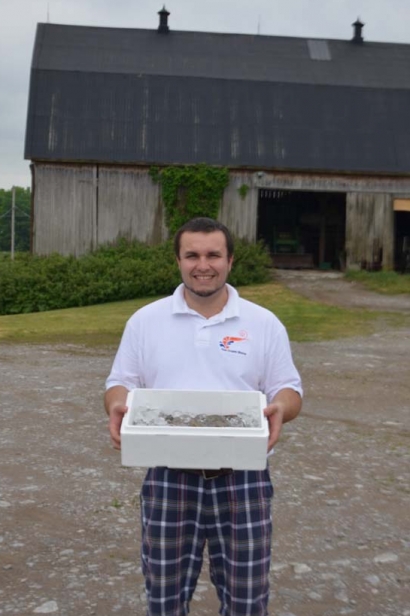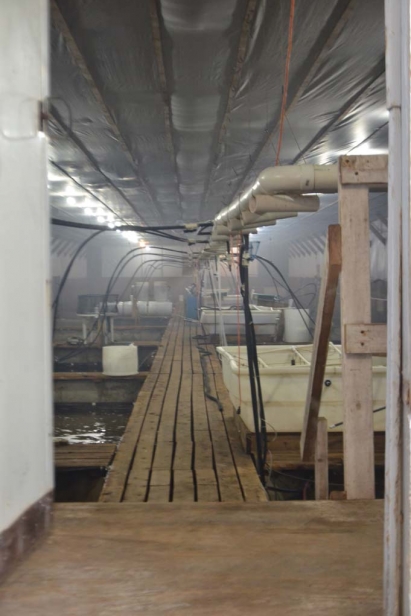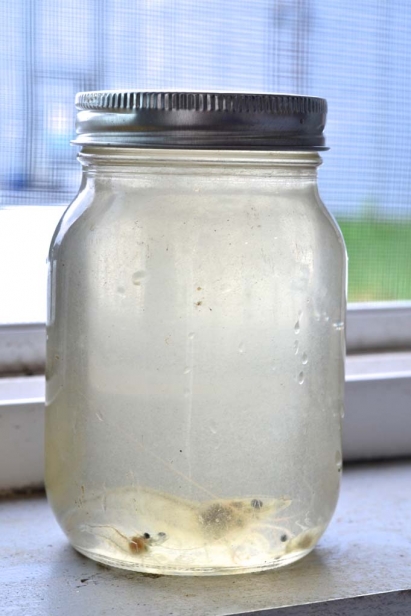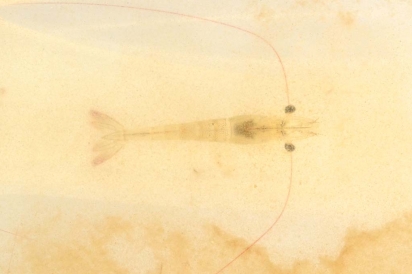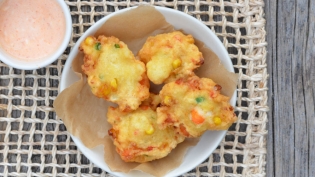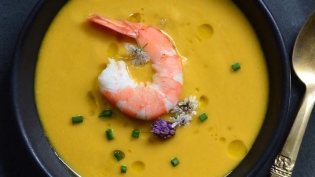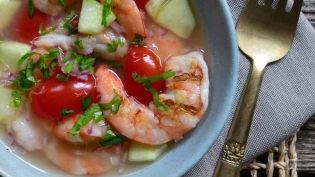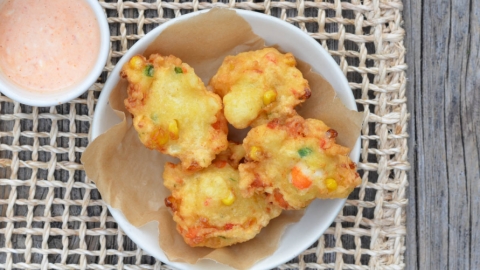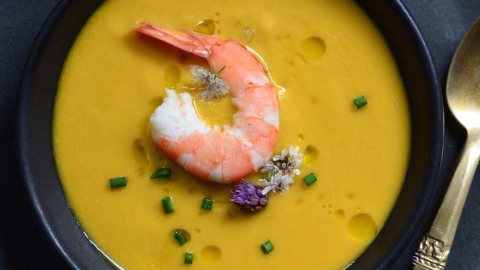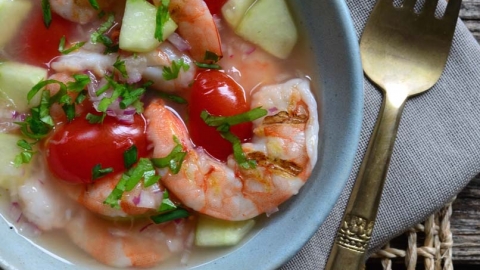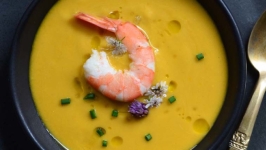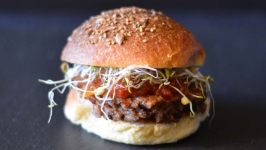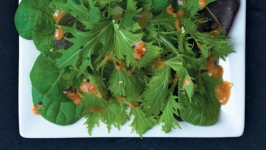Local Shrimp - First Ontario Shrimp
Paul and Tracy Cocchio have spent much of their lives working the 450-acre farm they own south of Campbellford, Ont. They raised dairy cows, then pigs until hog prices took a tumble in the early 2000s.
With the farm losing money, Paul decided to investigate other uses for his livestock barns. His research took him to the Midwestern U.S. where farmers in Indiana, Iowa and other states were converting chicken barns into closed-containment facilities for raising shrimp.
The more Paul learned, the more inland shrimp farming sounded like a good business opportunity. North Americans are crazy about shrimp and eat more of it than any other seafood, but it’s an appetite that exacts an environmental and human toll. Most of the shrimp we eat are imported from Southeast Asia, where they are typically raised in open-net pens that allow the free exchange of waste, chemicals, parasites and disease between the pens and the ocean. Another issue is the prevalence of slavery in the production chain in Thailand, the country that supplies a majority of the world’s shrimp.
So why not produce the seafood people love closer-to-home, using sustainable techniques?
Their decision made, Tracy and Paul plunged into the new venture. Partnering with son Brad, they spent five years setting up Ontario’s first inland shrimp farm, fittingly named First Ontario Shrimp. Since its launch in 2014, it has won plenty of media attention and developed a thriving restaurant clientele in Toronto that includes upscale eateries Momofuku and Nota Bene. In fact, demand has been so strong that the Cocchios haven’t had to do much marketing: the benefits of the shrimp speak for themselves, Brad says. “They’re produced here in Ontario, without hormones or antibiotics and with none of the horror stories you hear about with shrimp that come from other parts of the world.”
But making the transition from hog farming to pioneering shrimp production wasn’t easy.
Paul and Brad did much of the work to convert one of their hog barns, removing animal pens and slotted floors from the 200-foot by 40-foot space and equipping it with poured concrete tanks, 20,000 gallons of artificial sea water and aeration pumps. They also had to navigate a sea of government procedures to obtain the necessary licences and permits. For example, it took three years and lots of paperwork to get the jumbo Pacific white shrimp they wanted added to the list of species that can be legally farmed in Ontario.
But by far the biggest challenge was learning how to successfully care for the shrimp from post-larval, or pl, stage through to harvest. About the size of an eyelash, the baby crustaceans can get sucked into water pumps and are susceptible to minute fluctuations in temperature and feed. “To give you an idea, we were only able to harvest five pounds of shrimp from our first tank,” Brad says. “Now we get 100 to 125 pounds a week, with 20 to 25 shrimp per pound.”
Every other week, First Ontario Shrimp receives a shipment of 22,000 shrimp pl’s from a pathogen-free hatchery in Florida. They arrive in water that Paul and Brad have to acclimate, or match, to the water in their starter tanks so that when the pl’s are released, they don't get a shock that kills them. After a month, the shrimp are moved to grow-out tanks where they take roughly three months to attain their full size of 20 grams. Then they’re scooped out with a net, sorted, put on ice in coolers and loaded onto Paul’s half-tonne truck to make the trip to customers in Toronto.
To get the best possible results, Paul and Brad are constantly fine-tuning their methods and have built some of their own proprietary equipment and solutions. For example, when customers complained that some of the shrimp weren’t big enough, Paul designed a kind of trampoline to sort them so that smaller ones can to be returned to the tank for another few weeks of growth.
Same-day delivery is also part of the Cocchios’ commitment to quality, along with their decision to always sell whole shrimp that’s fresh, instead of frozen. “With the head on, you can look at the eyes and tell how fresh it is,” Brad says. “The eyes will be bright and clear if the shrimp is fresh, and cloudy if it’s past its prime.”
Farms with land tanks like First Ontario Shrimp provide an ecofriendly alternative to open-net pens, says Teddie Geach. She’s the seafood specialist at Ocean Wise, a Vancouver Aquarium conservation program that partners with the Cocchios and other producers who meet their criteria for sustainable aquaculture and wild fishing. “Having land-based farms here in Canada allows for fresh shrimp to be delivered to local markets and reduces the carbon footprint associated with importing shrimp from abroad,” she explains.
“What’s more, it’s nearly impossible for the fish to escape because they’re on land, and the water they’re raised in is discharged or recirculated instead of being in direct contact with the ocean.”
As part of its water recirculation system, First Ontario Shrimp uses something called Biofloc, an eco-friendly technology that employs beneficial bacteria to consume waste such as shrimp moults and excess feed. When the bacteria reach a certain threshold, the shrimp gobble them up, and if they overgrow, a filter strips them out. As a result of methods like these, the farm discharges just 40 to 45 gallons of water every two weeks.
The Cocchios appear to be doing the right things at the right time. Demand for sustainably produced shrimp continues to grow and has only intensified since the human-rights abuses in the Thai shrimp industry were exposed, Geach says. “Consumers are becoming more aware of where their food is coming from, so to have sustainable local options will be amazing.”
For customers, such as Toronto restaurant and cocktail bar Goods and Provisions, having a reliable source of top-quality Ontario shrimp is a godsend. “It’s amazing that we can get fresh shrimp that’s grown in this province,” says executive chef Roni Lageen. “It’s so fresh, it’s sweet and the size is consistent — an awesome product.”
The shrimp are also a hit at Honest Weight, a fish counter on Toronto's Dundas Street West that orders 40 pounds a week, and serves some of them at its in-store restaurant, cooked simply in brown butter and sage to showcase the flavour and texture.
Consumers who want to buy the shrimp directly can pick them up from the farm at 3 p.m. on Thursdays, provided they have placed their order by Tuesday of the same week. The Cocchios’ current price of $18 per pound compares well with the price of imported frozen jumbo shrimp in Ottawa, which ranges anywhere from $14.99 to $29.99 per pound, depending on the shrimp type, the per-pound count and the retail oulet.
The farm has heard from several Ottawa restaurants eager to order, too, but it would need to increase supply significantly to make that happen. The Cocchios would have to convert another barn, something they don’t have the manpower to do right now, especially with Brad working full-time as a cheesemaker off the farm and looking after the shrimp when he gets home. “Maybe some restaurants could get together and send a truck here,” he suggests. “We’re open to ideas.”
The Whalesbone Oyster House is one of the Ottawa restaurants keen to deal with First Ontario Shrimp Farm. “I'd love to be able to get a product like that into my restaurants, fresh head-on white shrimp, yummy,” says Michael Radford, executive chef for The Whalesbone Group. “It would be really nice if the farm was able to increase production and let more of Ontario enjoy this beautiful, sustainable and local product.”
First Ontario Shrimp
266 2nd Line E., Campbellford, Ont.
firstontarioshrimp.com, 705-653-3647
Seafood farming at-a-glance
With an estimated 70 per cent of all ocean species fully exploited, overexploited or in decline, aquaculture — the farming of marine or freshwater species under controlled conditions — offers a solution. But not all aquaculture techniques are created equal.
Here’s how they stack up, according to groups such as Ocean Wise and Sea Choice:
1. Open net pens allow free exchange of waste, chemicals, parasites and disease between the pens and the ocean. In addition, farmed fish that escape the pen can endanger wild populations by competing for food and habitat and breeding with other species.
2. Recirculating land-based tanks, such as those employed by First Ontario Shrimp, avoid many of the pitfalls associated with open-net pens. Escapes are almost impossible and water can be treated before being discharged or recirculated.
3. Raceways, or water channels, are typically used for raising rainbow trout. They can be sustainable as long as the fish can’t escape and the water is treated before it is discharged.
4. Ponds are a common shrimp farming method in Asia. They are unsustainable when they involve the destruction of mangrove forests and illegal or uncontrolled use of certain antibiotics, fungicides and pesticides.
5. Off-bottom farming is used to farm shellfish such as mussels, oysters, clams and scallops. It uses floating rafts, bags or suspended ropes so there is no contact with the seafloor and little or no bycatch.




